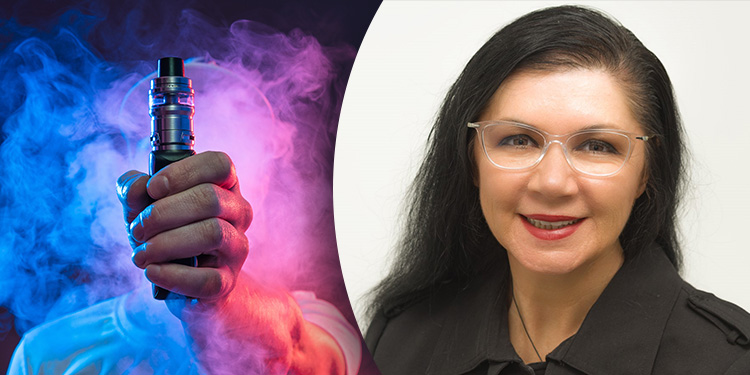
Dr Marewa Glover, Director of Centre of Research Excellence: Indigenous Sovereignty & Smoking, shares her predictions for vaping in 2022.
Vaping displaces cigarette smoking. That’s not a prediction, it’s a fact. New Zealand’s 2020/21 government health survey provides more weight to the evidence that vaping can increase quit rates, reduce smoking prevalence and is not a ‘gateway’ into smoking.
Like other countries that have allowed people who smoke to access at least one and sometimes a range of risk-reduced alternatives to cigarettes, New Zealand’s smoking and vaping stats now depict the same “perfect inverse correlation” – as vaping goes up, smoking goes down. Contrary to the fear mongering about vaping being a “gateway” to smoking, at least once a month smoking among young Kiwis aged 15 to 17 is down to an outstanding 1.4%.
We’re also not seeing an uptake in vaping among adults level off, as occurred in places where anti-vaping rhetoric scared people back to smoking. We still have a few commentators keeping the anti-vaping flame burning but, for the moment, theirs is a bit part. Once the government eliminates smoking via the proposed virtual removal of nicotine from tobacco, the negativity about vaping will no doubt increase so that the Smokefree Environments and Regulated Products law can achieve its second purpose which is: “to prevent the normalisation of vaping”; discourage people who do not smoke from taking up vaping or using smokeless tobacco products; and get people to stop vaping.
Encouraging switching from smoking to vaping
In 2022, countries supporting vaping will focus more on lessening the barriers to switching.
A major barrier to switching from smoking to vaping are anti-vaping lies flooding news media, social media and the scientific literature. Anti-vaping academics will continue to corrupt scientific platforms to sabotage harm reduction scientists and their research. To weight poorly conducted reviews that do little more than count how many papers are for or against, anti-vaping authors will continue to bombard publications and conferences with content that looks sciencey. The scientific value of much of that work will remain equal to that of propaganda flyers dropped from a war-time sky.
The battle to disseminate the truth and the even harder battle to get skeptics to hear and believe it will go on. The unfettered spread of disinformation to trick regulators and discredit good actors will also go on. Too many academics and anti-smoking NGOs are benefiting too much for honesty to be reinstated.
Improving customer service
A not insignificant barrier to switching is poor customer service, poor understanding of dependency on smoking, and selling the customer the wrong product.
In the early years of vaping, some companies were simply happy to have the orders pouring in. They were not concerned about churn – how many customers they were losing. They were not concerned about their conversion rate – how many customers who walked in the door did not buy a product. They had enough customers and some early entrants to the market couldn’t keep up with demand. That situation has changed. There is more competition now. In 2022, we will see more focus on innovation in customer service driven by risk-reduced product companies and harm reduction researchers.
An initial need is to build the capability of retail staff. I believe that training in why it can be hard for people to stop smoking will increase conversion from smoking to vaping. Improved understanding of what people need should lead to more customers buying a product that will be a satisfying substitute for their smoking experience. Retailers that embrace that learning will begin to outstrip competitors who are just selling vape kits as if they are one-size-fits-all widgets. A remaining threat to this is that single-brand retailers won’t want to refer customers to a competing product. They’ll keep saying my product will work for you.
Independent vaping advocates will need to provide platforms and resources, videos, courses, and information directly to people who smoke to empower them to understand better which type of product, flavour, and nicotine strength will work for them.
Regulatory intervention to push cessation
The success of vape shops caused a reduction in customers for government-funded cessation services. Concerned that people were not getting the quit smoking then quit vaping message, some governments have restricted what vape shop staff can say. The public is being directed back to approved government-controlled counsellors.
But smoking cessation services have only ever been acceptable and used by a very small percentage of people who smoke. Further, they achieve abysmal quit rates compared with the peer-to-peer model of support that was natural to the early vape shops.
Smoking cessation counselling can work for some people. But for a majority of people who smoke, the underpinning medical model that establishes the counsellor as an authority sent to heal the sick, weak-willed and impoverished is not a therapeutic dynamic.
Rivalling the vape shop peer-to-peer model is the understudied but innovative retail model, that sells cessation much like the fashion industry sells clothes. With this model, the power dynamic does not diminish the customer. Retail staff are not equals, as in the peer-to-peer model, they are attendants paid to serve the customer. Like clothes shops that offer free alteration services, some risk-reduced product companies offer free 24/7 phone and web-chat support to completely switch and stay off smoking.
Forcing vape shop staff through the medical model grinder could result in them becoming as ineffective as the government’s smoking cessation counsellors. The peer-to-peer model that worked in the early days for vapers, will be corrupted and it is important that it is not.
This is a good example of how regulators, who do not understand the new risk-reduced products and or who don’t understand nicotine dependency, pass laws that prohibit retailers from providing the customer who needs a 24mg vape liquid with a 24mg vape liquid.
Will people wake up?
In 2022, some more countries that have been duped into banning or severely restricting vaping will realise they’ve been lied to and some of them will backpedal. One thing that will help this to occur is that we will see more academics, scientists, and medical doctors, who were anti-vaping, quietly stop dissing vaping. They will start claiming that they were always behind it and that they deserve the accolades and the awards for the reductions in smoking.
Professor Marewa Glover, a Maori behavioural scientist, is one of New Zealand’s leading experts on tobacco, vaping and smoking cessation. She has worked on reducing smoking-related harm for almost 30 years and has over 150 scientific papers and reports. She is recognized internationally for her research on reducing smoking among Indigenous Peoples. In 2019 she was one of three finalists in the New Zealander of The Year Awards. In 2018, Dr Glover established her independent Centre of Research Excellence: Indigenous Sovereignty and Smoking. The Centre of Research Excellence: Indigenous Sovereignty and Smoking has an international focus on reducing tobacco related harms among Indigenous Peoples globally.
